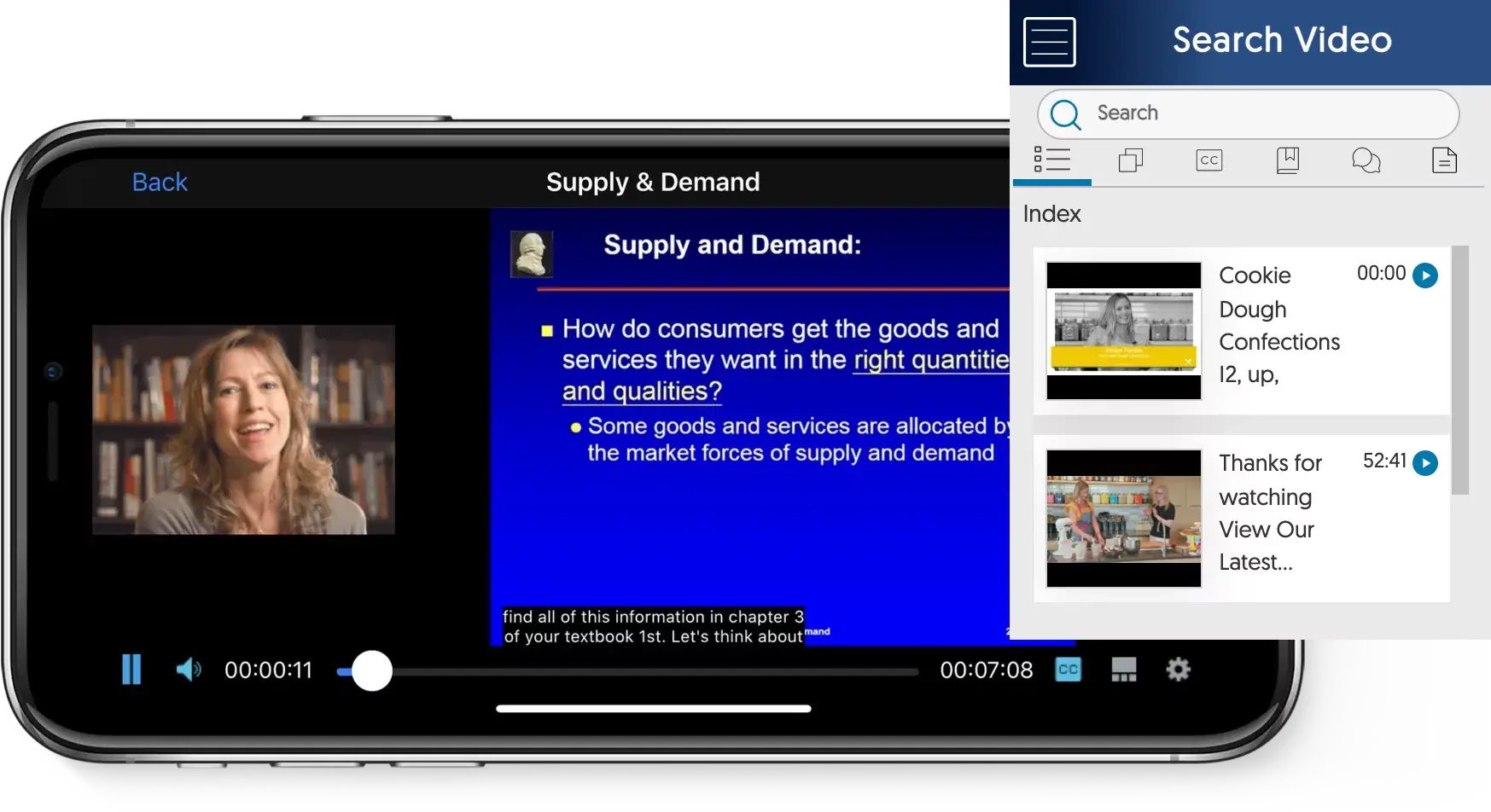Improve Employee Onboarding with Video Training
Effective employee onboarding helps maximize productivity, reduce stress, and improve staff retention. In fact, employee onboarding is one of the best uses of HR teams, providing significant reward for both new employees and corporations or institutions.

Well-executed onboarding leads to both increased profits and improved employee satisfaction. Research shows that great employee onboarding:
- Improves retention by 82%
- Increases productivity by 70% and
- Is critical for the success of new hires, with 93% of employers surveyed saying the experience was key to success in an employee’s role.
Using tools provided within the YuJa Enterprise Video Platform, trainers can provide onboarding activities in a variety of ways, such as:
- Micro-lesson video recording, which facilitates corporate microlessons;
- Social learning, which allows real-time discussion and promoted media engagement; or
- span style=”font-weight: 400;”>Video conferencing, which offers engaging options for virtual lessons, desktop sharing, collaboration and more.
Create Quality Onboarding with E-Learning and Video Content
“Companies want to help employees adjust to the corporate culture, provide needed information for employees to perform their job functions, and improve overall productivity of new hires.”
The goals of onboarding are relatively simple. Companies want to help employees adjust to the corporate culture, provide needed information for employees to perform their job functions, and improve overall productivity of new hires.
Quality onboarding:
- Aligns new hires to corporate themes, culture, and goals.
- Provides self-sufficiency for new employees.
- Increases employee satisfaction.
- Builds a good image of your company.
Opportunities to Enhance Onboarding
Even well-designed onboarding programs can have some areas for improvement.
- At many companies, employee onboarding is short and focuses on paperwork. It may, at some companies, last only a day to a week. To remedy this, add online and video learning elements to your onboarding.
- Onboarding programs may not meet the needs of different types of learners. To help work through this, incorporate things like quizzes, visual presentations, webinars, and other elements that help all new hires be successful.
- Common onboarding strategies may not provide cross-functional insights or information about the skills of new employees that will help them as they begin collaborating and working outside with other departments.
Consider Implementing Pre-boarding at Your Company
Onboarding often begins on the first day of work; however, more and more companies are introducing pre-boarding, which is when a new hire receives essential information before they officially begin their work duties.
Pre-boarding does not have to be intensive to be effective, and it doesn’t even need to be face-to-face.
- Provide employees with information about where to go, who to see, and how their day will go before the first day. Make sure that details about parking, security, and commonly asked questions are addressed. Video tours are an ideal way to share this with your new hires.
- Take care of essential paperwork ahead of time. This reduces the work required on the first day and allows employees to move straight to more active onboarding. Online video tutorials are an effective support for this paperwork.
- Make sure employees have the name and contact information for key staff, including their supervisors and human resources.
Pre-boarding can be done via email, online, or through video. You can even provide pre-boarding information on paper when an employee is hired.
Improving Onboarding for Your New Hires
Modern onboarding is moving out of the traditional office space, and in new directions. Implementing some of these strategies can make onboarding more rewarding for your employees, help them reach maximum productivity, and work to create a unified (and happy) corporate culture.
Good onboarding makes a difference for companies, for managers and for new hires. Setting up your new employees for success benefits everyone in the office, from the top down.
Bring Lectures to Students On the Go with YuJa’s Mobile Apps
Bringing educational tools to students, where they are and when they have time available provides them with the support they need to succeed in higher education. YuJa offers native mobile apps for both iOS and Android devices, which enable instructors and students alike to create recordings, upload media and download content for offline review.
THE YUJA MOBILE APP EMPOWERS STUDENTS AND INSTRUCTORS
The YuJa app is an ideal addition to the YuJa learning platform. It enables students to access:
- Course lecture captures.
- Uploaded external video content from the Media Channel.
- Social learning features, including real-time discussions.
Additionally, the Video Platform offers a HTML5-based media player designed for optimal device playback. They provide adaptive bitrate streaming, network-sensing technology and interactive capabilities.
Users can simply download the YuJa app from the Apple App Store for iOs or the Google Play store for Android devices and log in using their SSO, either with their established YuJa login or a login provided via email (for institutions that rely on LTI-Integration). This maintains login for a set duration of time, offering students increased ease of access.
YUJA MOBILE APPS PROVIDE REAL-WORLD APPLICATIONS
The YuJa mobile app facilitates learning in a wide variety of situations with exceptional practicality for hands-on training in various fields since the device and lectures can accompany the student wherever they go.
- With the mobile app, a medical student can watch or re-watch a procedure or demonstration from multiple angles. This provides ongoing support for students during training, improving their ability to learn and maximizing the effectiveness of hands-on training.
- During student teaching or teaching practicums, students in the education field can take techniques and lessons from lectures with them to their new classrooms to support their students.
- For engineering and other technical students, integrated presentation media mean that lecture captures can bring diagrams and blueprints home, to the lab, or to the office on a mobile device.
Remote vs Online Learning: What’s the Difference?
The terminology has caused confusion among students and the public at large, but the main differences lie in planning and preparation for these courses.

Remote learning:
- This type of education is an “emergency measure used to assure continuity of learning.”
- Faculty must quickly adapt and use whatever tools are at their disposal, even if they’re not designed for educational purposes.
- This type of education may lack user experience if instructors aren’t trained to use available resources.
- Students may or may not have access to technology and internet connectivity needed to fully participate in courses without institutional technology at their disposal.
Online learning:
- Online courses are purposefully planned and designed to function in an online environment.
- Technology and tools are selected to support the instruction and to help meet objectives.
- Faculty are trained and supported in their use of online teaching tools.
- Students only enroll in the course if they have the technology and tools to help them be successful.
During the pandemic, many realized that the flexibility of online learning is a benefit that should be afforded to all students, even beyond lockdowns and emergency situations. To that end, selecting technology to support true online learning is critical.
Create a Successful Online Course With Tools that Support Online Learning
“Courses and content should be available 24/7, so students can learn anywhere, and using any device.”
For a successful online learning experience, a strategic approach must be taken to ensure:
Availability. Courses and content should be available 24/7, so students can learn anywhere, and using any device. Offering downloadable documents for offline viewing, adaptive bitrate playback, and delivery that facilitate support across a broad range of devices all will help students and instructors be successful.
Accessibility. Courses should be accessible to all, including providing accessibility features like closed-captioning, high contrast options, compatibility with screen readers, and adherence to standard accessibility templates and frameworks.
Interaction. Enabling interaction between the instructor and students, and among learners, is important to facilitate idea and knowledge sharing. Each individual should be able to contribute to the learning process.
Integration. Learning tools should all work together to support your learning ecosystem. Ensure your solution includes enterprise connectors and integration points for cross-compatibility with your LMS, SSO, and other learning tools.
Support. Train and support both instructors and students in their online educational journey.
Inside Higher Ed concluded that as institutions work to meet the needs of students, they must intentionally design online learning. “We certainly do not expect all courses to be online in the future, but institutions would do well to support all faculty in leveraging digital learning tools and best practices… To best employ such tools in serving students, institutions will need to rely on thoughtful technology selection, faculty development, instructional design and application of proven frameworks to best ensure quality online learning.”
Competency-Based Learning: How to Support Non-Traditional Students
What Is Competency-Based Education?
 Competency-based education (CBE), or personalized learning, combines the assessment of existing skills with mastery-based academic progression. With this model, instructors assess the knowledge and experience students already possess through work and life experience. Then, individualized educational plans can be created to best meet the needs of non-traditional learners, many of whom are in the workforce as they work toward earning a degree.
Competency-based education (CBE), or personalized learning, combines the assessment of existing skills with mastery-based academic progression. With this model, instructors assess the knowledge and experience students already possess through work and life experience. Then, individualized educational plans can be created to best meet the needs of non-traditional learners, many of whom are in the workforce as they work toward earning a degree.
Learner-centric in nature, interest in CBE has grown in higher education over the past decade, and adoption efforts span all institution types, according to the National Survey of Postsecondary Competency-Based Education (NSPCBE).
CBE FOR NONTRADITIONAL LEARNERS
“More research is needed, but early indications suggest that CBE programs often serve a greater proportion of students with prior credits than traditional programs, and institutions price their CBE programs so that the amount students pay may be similar to or lower than for traditional programs,”
Personalized learning solutions offer improved access to education, particularly for non-traditional learners such as adults who are returning to school after years away, and students with families.
“More research is needed, but early indications suggest that CBE programs often serve a greater proportion of students with prior credits than traditional programs, and institutions price their CBE programs so that the amount students pay may be similar to or lower than for traditional programs,” the report noted.
For a student with significant relevant experience, course progression may occur quite rapidly. Non-traditional students may find personalized education more manageable and affordable.
YUJA AND COMPETENCY-BASED EDUCATION
Traditional classroom structures can fail to support competency-based learning—these set-ups require students to move through material at approximately the same pace, regardless of personal understanding.
YuJa provides video capture and integrated social tools that enable students to tailor their learning path to reflect their strengths and interests, as well as tools that make attending flipped courses more convenient for the student and easy for the instructor.
INCREASING COMPETENCY-BASED LEARNING IN HIGHER EDUCATION
Competency-based learning leans on innovative technological solutions to help non-traditional students thrive. A 2020 State of the Field study by American Institutes for Research found that between 2018 and 2020, 128 unique institutions have reported offering at least one operating CBE program, for a total of 1,057 CBE programs.
Further, 82% of institutions expect the number of CBE programs in the US to increase in the next five years.
“Despite the major disruptions to institutional operations due to the COVID-19 pandemic, we see evidence of growth in programs and optimism about the future of CBE, even though barriers remain,” it concluded.
Case Study: Entire North Dakota University System Relies on YuJa to Deliver Top-Notch Educational Experiences
“One of our institutions, University of North Dakota, started an RFP for a video service, so we decided to join their search along with the other 10 institutions,” explained Randy Wald, Operations Manager, Academic Services and Training. Wald and his team support learning technologies across the system, as well as provide training and best practices.
Based on usability, tools offered, its clean aesthetic and affordability, YuJa came out on top.
Read the full case study here.
The iPhone’s Effect On Our Society
A reason that I believe iPhone has the popularity is because in our society there has been a line drawn between iPhone and Samsung or any other brand of smartphone. People believe there is a better quality in speed, camera, apps, and other features of the iPhone.The reason why this is the biggest influential in today’s society is because it affects everyone including who do have an iPhone and those who do not. The iPhone allows users to call,text,surf the web, use apps, facetime (video chat), and other tools. One of the biggest problems in society has been produced from all of the uses that are available on this phone. In groups of people that are friends or family you would imagine interaction between them. In today’s society, almost everyone in a room is noticed to be on an iPhone or other brand of smartphone. I have experienced situations where I am with friends and everyone is just sitting on their phone. I think to myself wondering what the point of being with each other is when everyone is sitting on their phone scrolling.
“In today’s society almost everyone in a room is noticed to be on an iPhone or other brand of smartphone.”
One way I tried to solve this is I have told the people I was with to place their phones in a pile so that we could interact with each other. This is one way in which smartphones including the iPhone have affected our society while one more being the use of apps of social media. With so many people using iPhones it comes with the ability to use social media in an easier way that on the web. Social media influences our society in positive and negative ways. A beneficial way I have experienced is that it is an easy way to stay in touch with friends and family that are near and far. Of course you could call, but sometimes that is not always quick or they may not be available when you are. Social media is a quick casual way to see pictures and posts of how others are doing. One negative that has affected many people emphasizing young and older teens which is cyber bullying. With apps being at an easy access through iPhones and various smartphones people find it easy to say attacking words about or to people through their accounts on social media or even through text. Of course there was bullying before the smartphone, but this has given bullies an easy way to say what they want to people without having to face them.
Social media does have the option to report, but unfortunately some people will continue the bullying. Through social media,the way people are interacting with each other, and the dominance Apple has over other products I believe that the iPhone is the most influential piece of technology.
Editor’s Note: This essay was written by Anissah Surita, winner of the 2019 YuJa Essay Scholarship Contest. Learn more about Anissah here.
Location, Price, and Major: Three College Factors Important to Me
Because I still want to be kind of close near to home, it causes me to look at schools specifically in my state, California. Once I find a school I’m interested in, the next factor for me to hone in on is price. Although I have applied for scholarships and will complete the FAFSA with my parents, this does not guarantee I’ll receive an affordable college education. For my parent’s sake and my own, I will have to strongly evaluate the quality of the education I’ll be receiving and if it is truly worth the price.
“For my parents sake and my own, I will have to strongly evaluate the quality of the education I’ll be receiving and if it is truly worth the price.”
With many students graduating college with $30,000 in student loan debt, it is an important factor to look into early while there’s still time. Finally, I will also be considering what programs are available for the major I hope to pursue. I hope to major in political science and minor in either journalism or psychology. While all of these majors are available at many colleges, this doesn’t mean that your education in certain colleges will be the best. Because I plan to work in these fields when I graduate, it’s important that I get an education that prepares me for what I’ll encounter in these job fields daily.
If I am not equipped with the knowledge and real-world skills I can apply to my job after I leave college, then what is the point of going? If I focus on location, price, and programs for my major while deciding on the colleges I’m interested in, then I hopefully will be able to find a school that I truly love.
Editor’s Note: This essay was written by Christian Parham, winner of the 2017 YuJa Essay Scholarship Contest. Learn more about Christian here.
